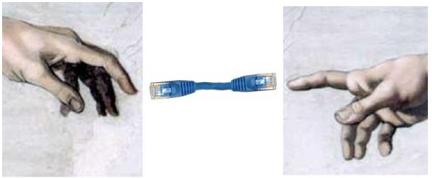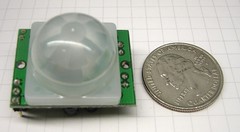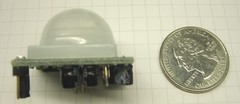From Translator: As far as I can tell from the video, it looks ordinary. However, reading this explanation, it sounds innovative. I wonder how I can use this for what, though. I can't think of any idea for it, from this mediocre brain....I was thinking that when I "touch" between DC and Toronto, it won't just be 356 miles between the two cities, but actually the "touch" signals will go between DC and Sunnyvale, CA (where the server is, 2429 miles away) and then to Toronto (2262 miles away), for a total of 4691 miles.
Friday, August 31, 2007
Touching distance
Wednesday, August 29, 2007
Big in Japan
Google language tools translate:
Perhaps Thomas Edwards of the friend who serves [aruhuagiku] with Dorkbot DC that (the other technical field artist includes) started wiki of new project. The name is, Phy2Phy, in addition name " the physical interaction on IP (physical interaction) “. The video of YouTube which is introduced here has become up-to-date report of that " touch " project. The pressure perception register was used, it is the system that 2 humans it is touched mutually via the net. Here cool hard is used the large quantity. The Comfile CUBLOC CB220 microprocessor and the Pololu micro serial servo controller, it is Lantronix Xport and the pressure sensor etc. As for all details and link, there is the page of Touch Project of Phy2Phy. Thomas is the expectation which announces halfway lapse with Dorkbot DC September 10th.
From translator: If you looked at video, but with plainness when explanation is read, you can think enormously in epoch-making ones, don't you think?. Whether so being able to utilize in something. At the point where the ordinary person it is sad for such idea not to emerge, .......
Thursday, August 23, 2007
Interesting Thesis
(Karen A. Verschooren - MIT)
This thesis provides a critical analysis of the relation between Internet art and the traditional institution for contemporary art in the North American and West-European regions. Thirteen years after its inception as an art form, the Internet art world finds itself in a developmental stage and its relation to the traditional institution for contemporary art is accordingly. Through an elaborate discussion of the key players, institutions and discourses on aesthetics, economics and exhibition methodologies, this sociological analysis of the past and current situation hopes to offer a solid ground for extrapolation and predictions for Internet art’s future as an art world in its relation to the traditional art institutions.
Tuesday, August 21, 2007
Washington Post mention
Washington, D.C.: I read in the Post about the great success of Tom Greaves's street installation "The Compliment Machine," which dishes out compliments to people as they walk by.
Then I read online about an Artomatic artist who had a similar machine called "Sycophant" a few years earlier but had very little notice.
Mr. O'Sullivan: Do you recall the Artomatic machine? Are they similar?
washingtonpost.com: The Art of Gratuitous Praise ( Post, July 21)
Michael O'Sullivan: I do remember "Sycophant" quite well. It was similar to the "Compliment Machine" in that they both dole out compliments, but "Sycophant," by Thomas Edwards, an artist who organizes DC's Dorbot meetings of tech/art people, was not just an impersonal box, but a robotic human head. It was rather hilarious, as I recall, saying things like, "You look really hot" and "I love your sweater."
...
Was Sycophant: the one next to the talking fish?
Michael O'Sullivan: Yes! That was the one. The fish--an altered version of one of the Big Mouth Billy Bass novelties--shouted out things like: "They're eating my eggs!" By the way, you can find more about the monthly DC Dorbot meetings (where art and tech collide) at http://www.dorkbot.org/dorkbotdc/.
Links: Sycophant, School of Fish Pain, Dorkbot DC
Saturday, August 18, 2007
VMUSIC2 on Arduino

I've long been seeking the "Holy Grail" of audio systems for interactive art installations:
1) High quality audio
2) Doesn't depend on a PC
3) Inexpensive
4) Uses some kind of standard flash memory (like SD), preferably with MP3 files.
5) Easy to interface to
So finally this showed up as the Vinculum VMUSIC2. This module takes a standard USB Flash drive for storage, can playback MP3 files, is controlled with a rich set of commands over a serial connection, and costs $41 from Mouser. The only challenge is that the Vinculum documentation is a little unclear whether the VMUSIC2 is DTE or DCE, and it also needs RTS and CTS to work the serial connections.
With some helpful hints from SurplusGizmos, I was able to get the VMUSIC2 to work with the Arduino.
Arduino TX to VMUSIC2 RX
Arduino GND to VMUSIC2 GND and VMUSIC2 CTS#
Arduino 5V to VMUSIC2 5V
This provides a way to write commands to the VMUSIC2 from the Arduino. If you want to hook up the VMUSIC2 TX and get sneakier with CTS# you can have bi-directional communication, but at first I just wanted to see if I could play any files.
On the Arduino side, the key code is:
Serial.begin(9600);
Serial.print("V3A"); #play all files
Serial.print(13,BYTE);
delay(5000); #wait five seconds
Serial.print("VST"); #stop playing
Serial.print(13,BYTE);
Note that there is only one serial port on the Arduino, which is shared between the serial pins and the USB connector. So when you program the Arduino, disconnect the VMUSIC2 RX connection so the programming effort doesn't confuse it, then when the programming is done, hook the VMUSIC2 RX back up to the Arduino TX pin.
Also note that Serial.println("V3A") doesn't quite work, I think it must send carriage return and linefeed, and the linefeed confuses the VMUSIC2.
Finally, while the VMUSIC2 doesn't draw too much power, I noticed that if I plugged it into the Arduino +5V while the Arduino was running that it reset the Arduino. So you may need to add an external +5V regulator for the VMUSIC2 to make sure it runs dependably.
Wednesday, August 15, 2007
Phy2Phy

I've officially "unleashed" the Phy2Phy Project Wiki to nurture the creation of networked artworks that link one physical world with another physical world over the Internet.
And Gareth Branwyn was cool enough to post it to the Make blog, yey!
The site Phy2Phy is on, Wikidot.com is very cool! I've been messing around with my own TikiWiki for a while, but it was too hard to configure all the bells and whistles. Wikidot.com is much easier to set up, and combines a Wiki with the ability to have a forum as well.
Monday, August 13, 2007
Parallax PIR Sensors



These are some of the smallest integrated PIR sensor units you can find, plus they are pretty cheap. They actually are a bit larger than I had thought before I purchased them, but still they are really small compared to the units you typically find for security purposes.
I didn't know what to expect with regards to performance, but I tested them and they were capable of detecting motion out to at least 15 feet away. They take 3.3V to 5V supply voltage and have 3.3V output logic.
Their small size makes them useful for applications where you might want to put them at the end of a tube to create motion detectors with a very thin field of view.
Sunday, August 12, 2007
Friday, August 10, 2007
2mm header sockets
So does DigiKey...even 12 pin x single row.
These would be useful for mounting the Lantronix Xport Direct.
Update: Mouser has 2mm protoboard (from "SchmartBoard") 2x2 inches which is just big enough for the Lantronix Xport Direct. For some reason, the cheapest Vectorboards are $13 in 2mm grid, and larger 2mm grid ones are very expensive (over $20).